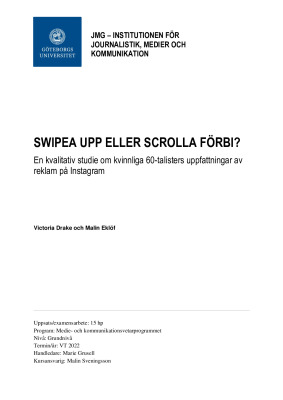SWIPEA UPP ELLER SCROLLA FÖRBI?
En kvalitativ studie om kvinnliga 60-talisters uppfattningar av reklam på Instagram
Executive summary
During the last decade, social media has become an increasingly important part of our everyday lives, as has the advertising that we are fed daily on various platforms and social networks. The advertising on Instagram has almost become as much a part of our daily feed as our friends’ updates, and it seems to be even more and more. Has it become too much, has the
real purpose of using Instagram been replaced by a feed filled with advertising rather than a platform for social interaction?
The purpose of this study is to investigate the perceptions of advertising on Instagram, the target group for the study is women born in the 1960s. We found a lot of studies about advertising, but very few that focus on an older generation.
To achieve the purpose of the study we have worked with three main questions, (1) what motivates the interviewees to use Instagram? (2) What attitudes do the interviewees have towards personalized advertising on Instagram? And (3) what significance does the credibility of advertising have on the purchase intention? The theoretical framework of this study
consists of Uses and Gratifications, The dynamic motivation activation model, The attitude model, and Electronic word-of-mouth. As well as previous study about advertising, attitudes about personalized advertising and purchase intention. To answer our questions we have conducted semi-structured interviews with 8 women born in the 1960’s.
Our results show that it is possible to identify several motives for women born in the 1960’s Instagram use. The most prominent motive was social interaction, both with friends and family. Followed by being part of a community and killing time. Secondly, the attitudes towards advertising on Instagram turned out to be appreciated, at least when the advertising is
one’s own choice. The general attitudes towards advertising were relatively negative at first, but when the advertising was directed and thus tailored to its interests, it was perceived as more positive. Lastly, our study revealed two groups with different opinions. One half found famous people and influencers advertising trustworthy and the other half had a negative
attitude. The results also indicate that the ones who follow famous people or influencers have consumed Instagram to a greater extent. In summary, it can be stated that there is a certain ambivalence about the perceptions of advertising on Instagram, it is perceived as both disturbing and at the same time appreciated. When there is too much advertising, and it interferes with the individual’s use of Instagram, it evokes negative emotions. At the same
time, the results of the study show that personalized advertising is perceived as something positive when it corresponds to the individual’s interests. Regardless of perceptions of advertising and that there is sometimes a tendency for too much advertising in users’ feeds,users still choose to continue using Instagram and see their time on Instagram as valuable.

